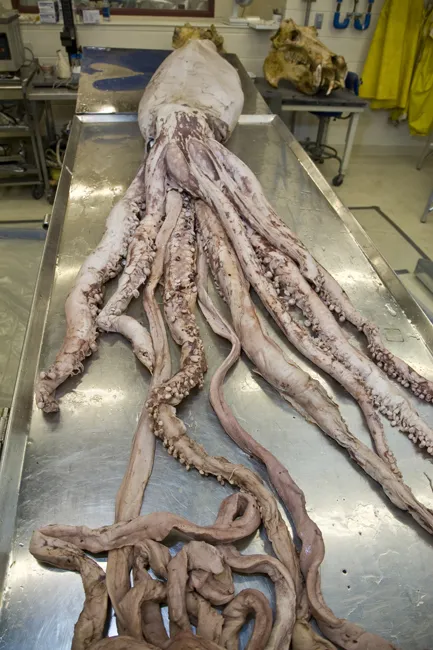The giant squid (Architeuthis dux) is a legendary deep-sea inhabitant, renowned for its immense size and elusive nature. Reaching lengths of up to 40 feet or more, it is one of the largest invertebrates on Earth.
Its eyes are specially adapted to detect faint light in the deep ocean, allowing the squid to spot prey and predators in the dark depths where it resides. This article will explore the unique adaptations and uncover intriguing facts about this mysterious ocean dweller. Curious how it stacks up against the giant Pacific octopus? See our in-depth giant squid vs. giant octopus comparison.
Appearance
This very large cephalopod can grow up to forty-three feet (thirteen meters) in length. Most of the length comes from their feeding tentacles, which can snatch prey up to thirty-three feet away (ten meters).

The tentacles shoot out and are tipped with hundreds of suckers covered in sharp teeth.
These squids have eight arms, along with the two feeding arms, and beak-like mouths inside the mantle. Two large fins attached to the mantle aid in maneuvering their massive bodies. After the squid bites through its prey, it continues to cut up prey with a radula inside the squid’s beak. The radula is a tongue-like organ that is covered with even more rows of teeth.
While giant squids rely on their long feeding tentacles for hunting, their relative, the giant Pacific octopus, uses powerful, shorter arms and far greater flexibility — a fascinating contrast in deep-sea predators.

The main part of the body is known as the mantle, it comprises all the essential organs except for the two feeding arms. Located on the underside of the mantle is a structure called the funnel, which plays a crucial role in exhalation, waste expulsion, ink squirting, jet propulsion, and egg-laying. It accomplishes these tasks by pumping water and other fluids through the funnel.
Did you know…
The giant squid’s eyes are about the size of dinner plates. At one foot in diameter (thirty centimeters), this makes them the largest eyes in the entire animal kingdom. These huge eyes make it easier for the squid to absorb light than smaller squid would and spot predators or bioluminescent prey in the dark of the deep ocean.
Habitat
Giant squid can be found in all the world’s ocean except tropical and polar waters. They live at extreme depths, around 1,650 feet (500 meters) to 3,300 feet (1,000 meters) deep.
They frequently wash up on shores around the world, especially in New Zealand, Polynesia, and the North and South Atlantic along coasts. Due to this, it appears the squid prefers continental and island slopes.
Diet
The giant squid diet likely consists of fish, shrimp, and other squid, and some suggest they might even attack and eat small whales.
Scientists have cut open the stomachs of dead giant squid that have washed up on beaches and investigated the contents. Contents of the stomachs of these investigations include prey like deep water fishes and other squids, even other giant squids.
They are known to attack schools of fish from below by quickly flying up toward the fish, grabbing some to eat, and then running away to the deeper depths. This is typical behavior of ambush predators like giant squids.

Reproduction
Giant squids reproduce through internal fertilization. The males use a specialized arm, known as a hectocotylus, to transfer spermatophores (packets of sperm) to the female. These spermatophores are deposited in or near the female’s mantle cavity.
Once fertilized, females release thousands of eggs into the water, where they develop and hatch into tiny larvae. Due to their deep-sea habitat, much about their reproductive behaviors remains a mystery, including specifics about mating rituals and the early life stages of the young squids.
Threats
The most notable threat to giant squid is sperm whales. They are so notable that they are even a bit notorious, and common culture has plenty of imagery of sperm whales locked in a fight with these elusive creatures.

There is also plenty of evidence of sperm whales fighting with giant squids, as pieces of whale skin have sucker scars covering them. There has been no evidence of giant squid winning these battles, nor have they been witnessed. Yet, there is plenty of evidence of the existence of giant squid beaks found in sperm whale stomachs.
5 More Curious Facts About the Giant Squid
- Giant squids are found worldwide but not in polar or tropical water.
- In 2004 researchers in Japan took the first images ever of a live giant squid.
- They use their funnel as a propulsion system, drawing water into the mantle, or main part of the body, and forcing it out the back.
- This colossal squid can weigh about a ton and can grow up to 40 feet long.
- Many photographs show it to appear red or reddish, especially when it is near the surface, but many squids are known to change their color at will.
FAQs
Why do giant squid live so deep?
They live at such depths primarily because their prey, including deep-sea fish and other squid species, is more abundant there. Additionally, the darkness provides some protection from predators like sperm whales. Giant squids have evolved to tolerate the immense pressure of the deep sea, and the colder temperatures may help slow their metabolism, allowing them to conserve energy efficiently.
Are giant squid aggressive to humans?
No, they are not typically aggressive towards humans. Despite their formidable size and appearance, there have been no documented cases of giant squids attacking humans in the wild. Their encounters with humans are extremely rare, and they generally avoid interaction.
Are giant squids krakens?
Not, but they are the most likely living creature to have inspired the modern notion of the Kraken or other giant cephalopods that attack boats.
Do giant squid attack boats?
While extremely rare, there are accounts of giant squids attacking boats, the most recent being in 2003.
When was the first living giant squid photographed?
In 1874, a giant squid was draped over a bathtub for the photo and was the property of Reverend Moses Harvey of Newfoundland.













